A Capacitated House Allocation Game for the Energy Efficient Relays Selection in 5G Multicast Context
Abstract
1. Introduction
- We propose a relay-based content delivery approach to offload the data traffic through D2D communications, by establishing energy efficient connections. In particular, multiple relays can be selected among all the interested users to spread the content and minimize the end-to-end delivery delay.
- The adopted matching process achieves the combinations of relays and destinations according to a reputation strategy and the propagation conditions of the links from source to relays and the links from relays to end-users with respect to the direct link (i.e., from source to end-users). This joint process minimizes the worst delivery delay and the number of the involved relays, by resorting to the capacitated house allocation matching problem.
2. Related Works
3. System Model
3.1. Reference Scenario
3.2. Problem Formulation
4. Proposed Solution and Algorithm
4.1. The RSP as an Instance of the CHA Problem
4.2. EDs Preference List
4.3. Proposed Algorithm
- if ED i prefers to , i.e., the ED i prefers to receive the packet l through the direct link connection, i proposes itself to , otherwise the proposal is sent to .
- both and select the minimum values and within and , respectively.
- Due to the fact that represents the first choice of among the received proposals, the SN establishes a direct link towards ;
- similarly, the SN selects as relay node in order to send the packet l to all the one hop neighbors of ;
- the topology is updated as follows:
- the ED cuts its incident edges;
- all the nodes belonging to cut their incident edges, while preserving the edge connecting themselves with . In fact, the edges that connect to its one hop neighbors are essential to reach all the neighbor EDs and to allow to act as a relay.
- ;
- each ED updates its preference list;
- repeat 1–9 until the set is not empty.
4.4. Practical Considerations
5. Numerical Results
5.1. Simulation Setup
- a threshold for the quality condition of the link towards each node is set. The threshold is expressed in terms of link delay;
- every link which satisfies the quality condition is selected as a relay link;
- the connection graph is updated in accordance with the degree of the nodes selected as relays;
- when any link has a quality greater than the fixed threshold, direct links are established until all the nodes are reached.
- the SN establishes direct links with the disconnected EDs, according to the topology of ;
- the SN selects as a relay node the ED at minimum distance;
- the topology of is updated;
- repeat 1–4 until all the EDs are reached by one link.
- the SN selects the direct link communication mode with the disconnected EDs in ;
- the SN selects with uniform probability whether to establish direct link or to select a relay node;
- the topology of is updated according to the previous decision;
- repeat 1–4 until all the EDs are reached by one link.
- during each step, establishes one direct link, as far as possible;
- during each step, selects one relay, as far as possible;
- during each step, establishes one direct link towards the most disconnected ED.
- during each step, selects as a relay the ED with maximum degree.
5.2. Performance Analysis
6. Conclusions
Author Contributions
Funding
Conflicts of Interest
Abbreviations
| Symbol | Description |
| source node | |
| set of EDs | |
| n | number of EDs in |
| l | packet |
| L | packet size |
| proximity graph | |
| vertex set of | |
| edges set of | |
| indices on set | |
| reputation coefficient | |
| degree of vertex i | |
| probability function | |
| transmission delay via direct link | |
| transmission delay passing by ED j | |
| total delay transmission | |
| number of selected relays |
References
- Asadi, A.; Wang, Q.; Mancuso, V. A Survey on Device-to-Device Communication in Cellular Networks. IEEE Commun. Surv. Tutor. 2014, 16, 1801–1819. [Google Scholar] [CrossRef]
- Release 12 3gpp. 2020. Available online: https://www.3gpp.org/specifications/releases/68-release-12 (accessed on 2 September 2020).
- Specification Details 3gpp. 2020. Available online: https://portal.3gpp.org/desktopmodules/Specifications/SpecificationDetails.aspx?specificationId=3389 (accessed on 2 September 2020).
- Bello, O.; Zeadally, S. Intelligent Device-to-Device Communication in the Internet of Things. IEEE Syst. J. 2016, 10, 1172–1182. [Google Scholar] [CrossRef]
- Tehrani, M.N.; Uysal, M.; Yanikomeroglu, H. Device-to-device communication in 5G cellular networks: Challenges, solutions, and future directions. IEEE Commun. Mag. 2014, 52, 86–92. [Google Scholar] [CrossRef]
- Höyhtyä, M.; Apilo, O.; Lasanen, M. Review of Latest Advances in 3GPP Standardization: D2D Communication in 5G Systems and Its Energy Consumption Models. Future Internet 2018, 10, 3. [Google Scholar] [CrossRef]
- Chiti, F.; Giacomo, D.D.; Fantacci, R.; Pierucci, L. Interference aware approach for D2D communications. In Proceedings of the 2016 IEEE International Conference on Communications (ICC), Kuala Lumpur, Malaysia, 22–27 May 2016; pp. 1–6. [Google Scholar]
- Biswas, S.; Vuppala, S.; Xue, J.; Ratnarajah, T. On the Performance of Relay Aided Millimeter Wave Networks. IEEE J. Sel. Top. Signal Process. 2016, 10, 576–588. [Google Scholar] [CrossRef]
- Wu, S.; Atat, R.; Mastronarde, N.; Liu, L. Improving the Coverage and Spectral Efficiency of Millimeter-Wave Cellular Networks Using Device-to-Device Relays. IEEE Trans. Commun. 2018, 66, 2251–2265. [Google Scholar] [CrossRef]
- Wei, L.; Cao, Z.; Zhu, H. MobiGame: A User-Centric Reputation Based Incentive Protocol for Delay/Disruption Tolerant Networks. In Proceedings of the 2011 IEEE Global Telecommunications Conference-GLOBECOM 2011, Houston, TX, USA, 5–9 December 2011; pp. 1–5. [Google Scholar]
- Desogus, C.; Anedda, M.; Murroni, M.; Muntean, G. A Traffic Type-Based Differentiated Reputation Algorithm for Radio Resource Allocation During Multi-Service Content Delivery in 5G Heterogeneous Scenarios. IEEE Access 2019, 7, 27720–27735. [Google Scholar] [CrossRef]
- Kar, U.N.; Sanyal, D.K. A Critical Review of 3GPP Standardization of Device-to-Device Communication in Cellular Networks. SN Comput. Sci. 2020, 1, 37. [Google Scholar] [CrossRef]
- Zlatanov, N.; Jamali, V.; Schober, R. Achievable Rates for the Fading Half-Duplex Single Relay Selection Network Using Buffer-Aided Relaying. IEEE Trans. Wirel. Commun. 2015, 14, 4494–4507. [Google Scholar] [CrossRef]
- Simoni, R.; Jamali, V.; Zlatanov, N.; Schober, R.; Pierucci, L.; Fantacci, R. Buffer-Aided Diamond Relay Network With Block Fading and Inter-Relay Interference. IEEE Trans. Wirel. Commun. 2016, 15, 7357–7372. [Google Scholar] [CrossRef]
- Krikidis, I.; Charalambous, T.; Thompson, J.S. Buffer-Aided Relay Selection for Cooperative Diversity Systems without Delay Constraints. IEEE Trans. Wirel. Commun. 2012, 11, 1957–1967. [Google Scholar] [CrossRef]
- Sarker, D.K.; Sarkar, M.Z.I.; Anower, M.S. Enhancing multicast capacity using opportunistic relaying. In Proceedings of the 2016 2nd International Conference on Electrical, Computer Telecommunication Engineering (ICECTE), Rajshahi, Bangladesh, 8–10 December 2016; pp. 1–4. [Google Scholar]
- Wang, Y.; Wang, W.; Chen, L.; Zhang, Z. Lexicographic Relay Selection and Channel Allocation for Multichannel Cooperative Multicast. In Proceedings of the 2017 IEEE Wireless Communications and Networking Conference (WCNC), San Francisco, CA, USA, 19–22 March 2017; pp. 1–6. [Google Scholar]
- Mishra, P.K.; Pandey, S.; Biswash, S.K. A Device-Centric Scheme for Relay Selection in a Dynamic Network Scenario for 5G Communication. IEEE Access 2016, 4, 3757–3768. [Google Scholar] [CrossRef]
- Shama, N.; Saxena, N.; Roy, A. Incentive and Penalty Mechanism For Power Allocation in Cooperative D2D-Cellular Transmissions. Electronics 2020, 9, 408. [Google Scholar]
- Zhao, Y.; Li, Y.; Cao, Y.; Jiang, T.; Ge, N. Social-Aware Resource Allocation for Device-to-Device Communications Underlaying Cellular Networks. IEEE Trans. Wirel. Commun. 2015, 14, 6621–6634. [Google Scholar] [CrossRef]
- Chiti, F.; Fantacci, R.; Pierucci, L. Social-Aware Relay Selection for Cooperative Multicast Device-to-Device Communications. Future Internet 2017, 9, 92. [Google Scholar] [CrossRef]
- Zhang, H.; Wang, Z.; Du, Q. Social-Aware D2D Relay Networks for Stability Enhancement: An Optimal Stopping Approach. IEEE Trans. Veh. Technol. 2018, 67, 8860–8874. [Google Scholar] [CrossRef]
- Huang, S.; Wei, Z.; Yuan, X.; Feng, Z.; Zhang, P. Performance Characterization of Machine-to-Machine Networks With Energy Harvesting and Social-Aware Relays. IEEE Access 2017, 5, 13297–13307. [Google Scholar] [CrossRef]
- Khwakhali, U.S.; Gordon, S.; Suksompong, P. Social-aware relay selection for device to device communications in cooperative cellular networks. In Proceedings of the 2017 International Electrical Engineering Congress (iEECON), Pattaya, Thailand, 8–10 March 2017; pp. 1–4. [Google Scholar]
- Xu, C.; Gao, C.; Zhou, Z.; Chang, Z.; Jia, Y. Social Network-Based Content Delivery in Device-to-Device Underlay Cellular Networks Using Matching Theory. IEEE Access 2017, 5, 924–937. [Google Scholar] [CrossRef]
- Xu, L.; Junhao, F.; Biyao, H.; Zhou, Z.; Mumtaz, S.; Rodriguez, J. Joint Relay Selection and Resource Allocation for Energy-Efficient D2D Cooperative Communications Using Matching Theory. Appl. Sci. 2017, 7, 491. [Google Scholar] [CrossRef]
- Biró, P.; Irving, R.W.; Manlove, D.F. Popular Matchings in the Marriage and Roommates Problems. In Algorithms and Complexity; Calamoneri, T., Diaz, J., Eds.; Springer: Berlin/Heidelberg, Germany, 2010; pp. 97–108. [Google Scholar]
- Sawyer, N.; Smith, D.B. Flexible Resource Allocation in Device-to-Device Communications Using Stackelberg Game Theory. IEEE Trans. Commun. 2019, 67, 653–667. [Google Scholar] [CrossRef]
- Bayat, S.; Li, Y.; Song, L.; Han, Z. Matching Theory: Applications in wireless communications. IEEE Signal Process. Mag. 2016, 33, 103–122. [Google Scholar] [CrossRef]
- Han, Z.; Niyato, D.; Saad, W.; Basar, T.; Hjørungnes, A. Matching Theory for Wireless Networks; Springer International Publishing: London, UK, 2017. [Google Scholar]
- Gu, Y.; Saad, W.; Bennis, M.; Debbah, M.; Han, Z. Matching theory for future wireless networks: Fundamentals and applications. IEEE Commun. Mag. 2015, 53, 52–59. [Google Scholar] [CrossRef]
- Manlove, D. Algorithmics Of Matching Under Preferences; Theoretical Computer Science; World Scientific Publishing: Singapore, 2013. [Google Scholar]
- Gale, D.; Shapley, L.S. College Admissions and the Stability of Marriage. Am. Math. Mon. 1962, 69, 9–15. [Google Scholar] [CrossRef]
- Roth, A.E. Deferred acceptance algorithms: History, theory, practice, and open questions. Int. J. Game Theory 2008, 36, 537–569. [Google Scholar] [CrossRef]
- Roth, A.E.; Sotomayor, M. Two-Sided Matching: A Study in Game-Theoretic Modeling and Analysis; Cambridge University Press: Cambridge, UK, 1990. [Google Scholar]
- El-Atta, A.H.A.; Moussa, M.I. Student Project Allocation with Preference Lists over (Student, Project) Pairs. In Proceedings of the 2009 Second International Conference on Computer and Electrical Engineering, Dubai, UAE, 28–30 December 2009; Volume 1, pp. 375–379. [Google Scholar]
- Chakrabarti, A.S.; Chakrabarti, B.K.; Chatterjee, A.; Mitra, M. The Kolkata Paise Restaurant problem and resource utilization. Phys. A Stat. Mech. Appl. 2009, 388, 2420–2426. [Google Scholar] [CrossRef]
- Park, T.; Saad, W. Kolkata paise restaurant game for resource allocation in the Internet of Things. In Proceedings of the 2017 51st Asilomar Conference on Signals, Systems, and Computers, Pacific Grove, CA, USA, 29 October–1 November 2017; pp. 1774–1778. [Google Scholar]
- Zhong, W.; Chen, G.; Jin, S.; Wong, K. Relay Selection and Discrete Power Control for Cognitive Relay Networks via Potential Game. IEEE Trans. Signal Process. 2014, 62, 5411–5424. [Google Scholar] [CrossRef]
- Shah-Mansouri, H.; Wong, V.W.S. Hierarchical Fog-Cloud Computing for IoT Systems: A Computation Offloading Game. IEEE Internet Things J. 2018, 5, 3246–3257. [Google Scholar] [CrossRef]
- Tian, Z.; Gong, Y.; Chen, G.; Chambers, J.A. Buffer-Aided Relay Selection With Reduced Packet Delay in Cooperative Networks. IEEE Trans. Veh. Technol. 2017, 66, 2567–2575. [Google Scholar] [CrossRef]
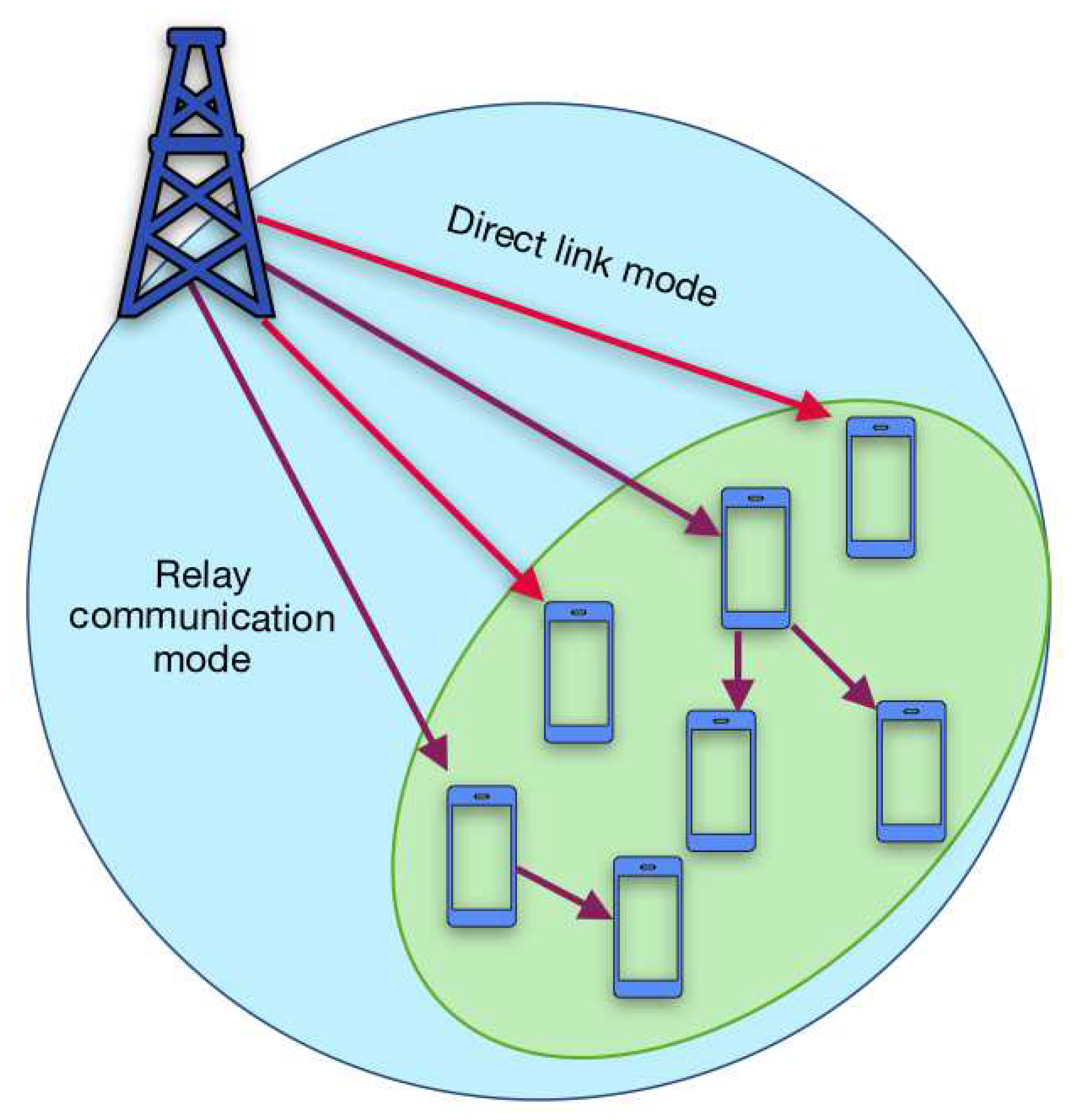
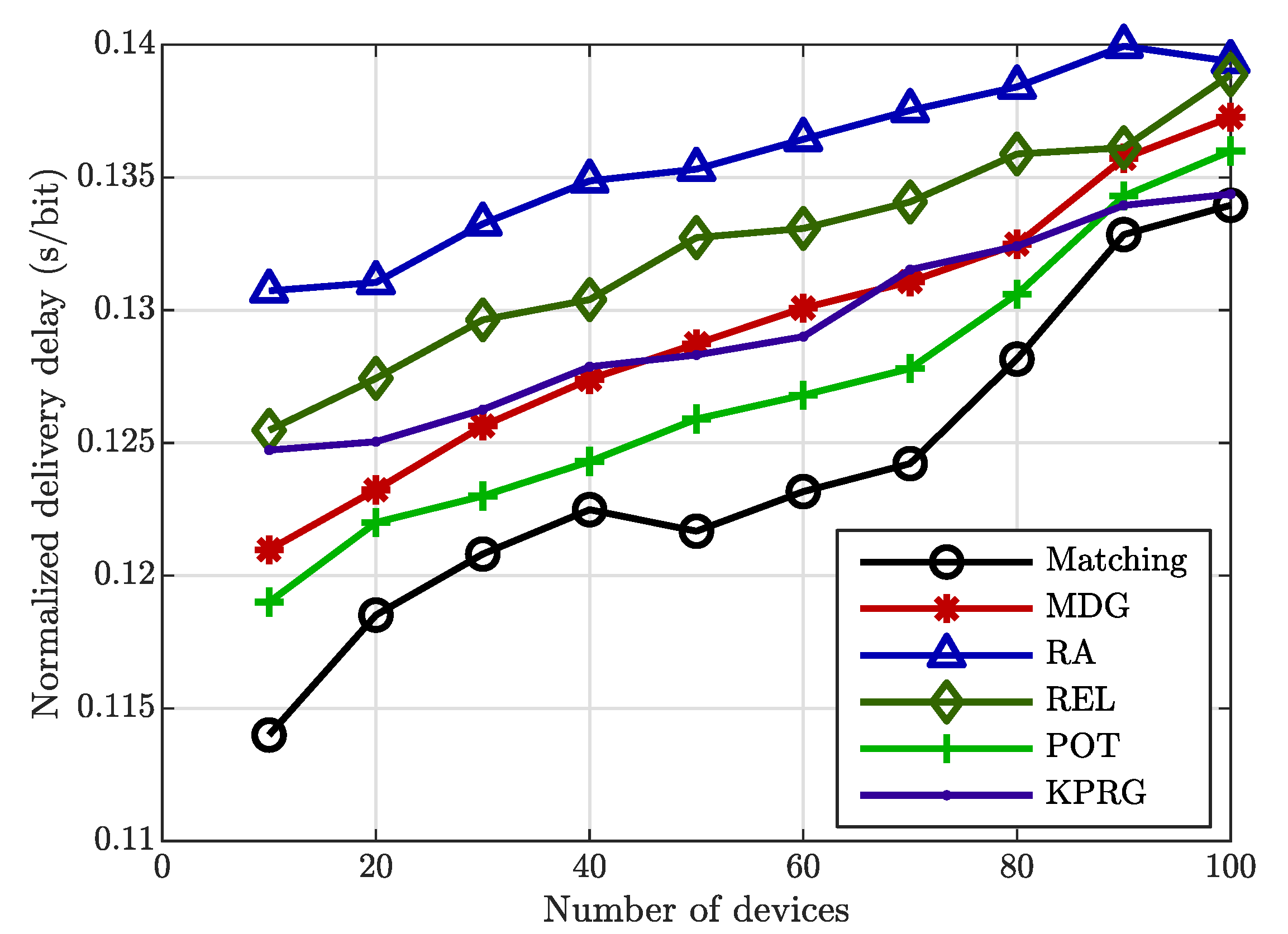
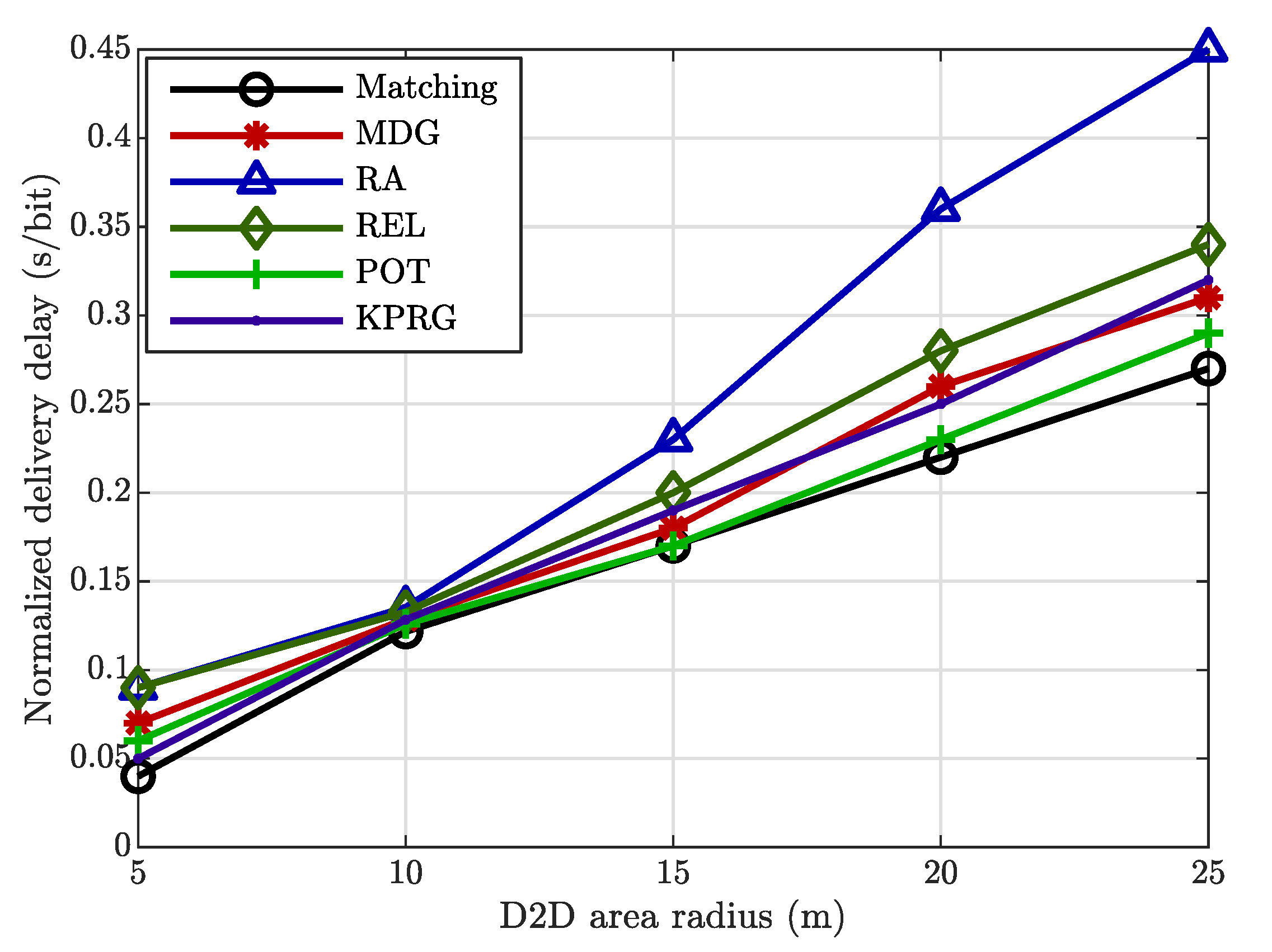

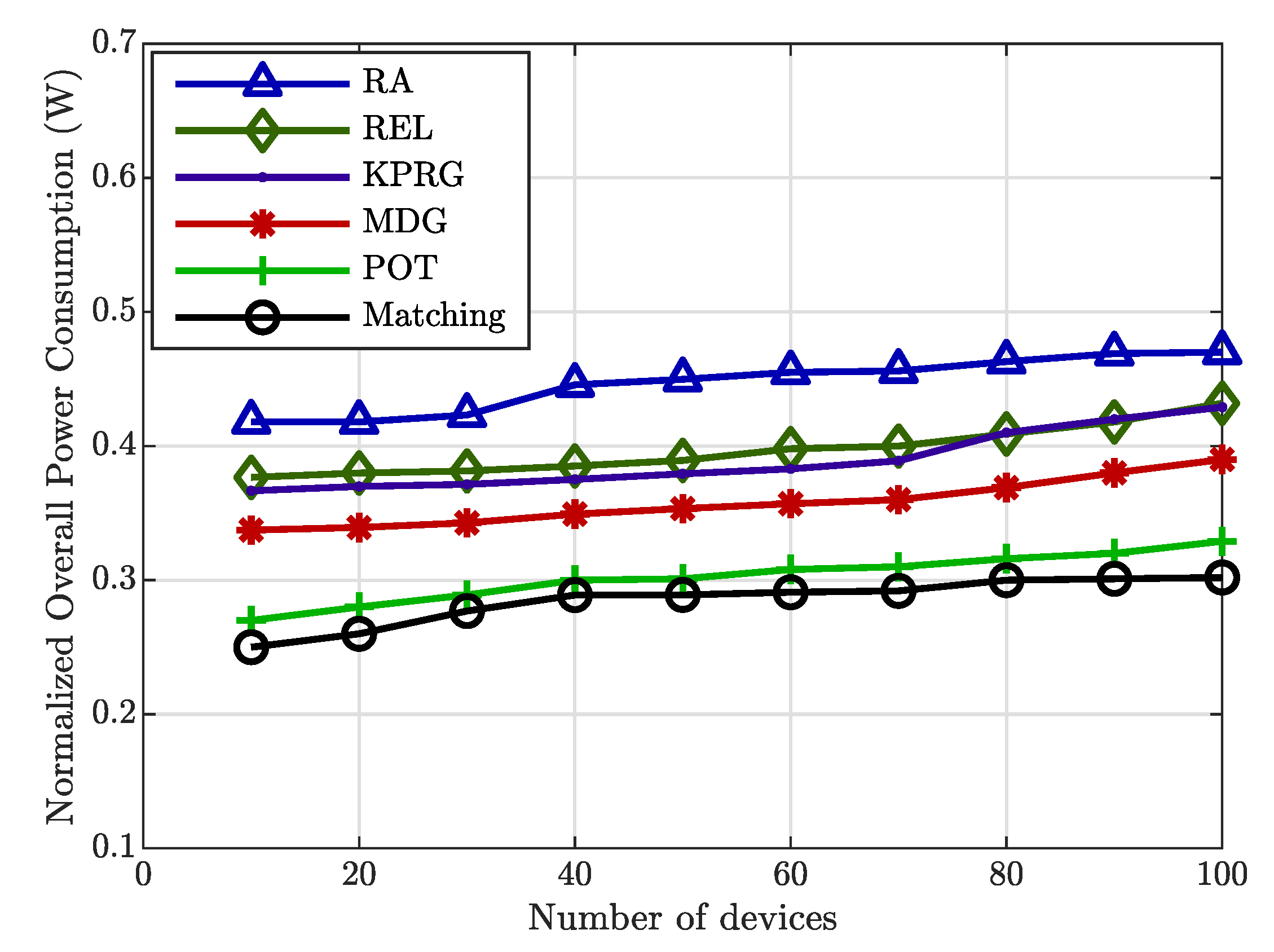
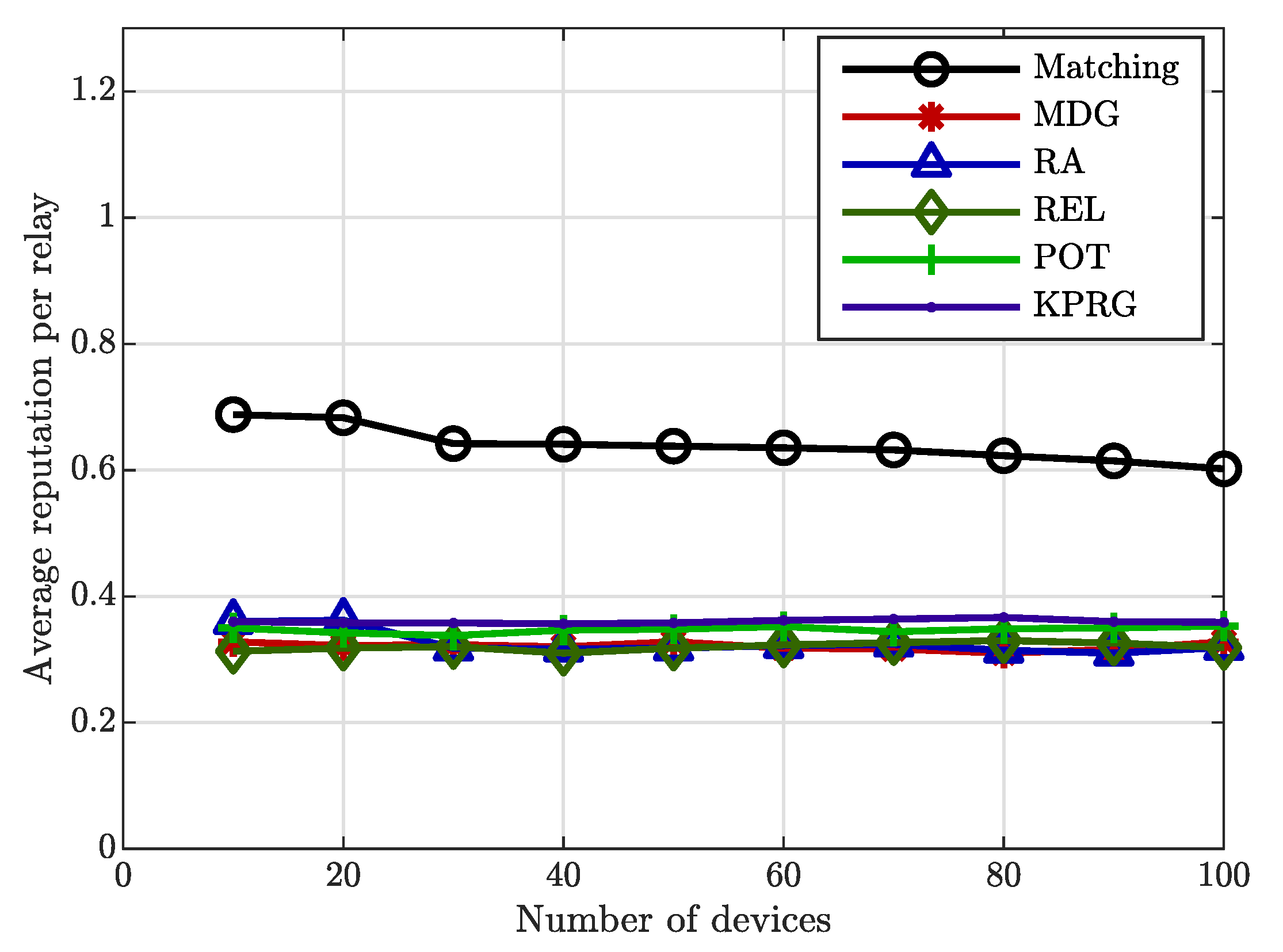
© 2020 by the authors. Licensee MDPI, Basel, Switzerland. This article is an open access article distributed under the terms and conditions of the Creative Commons Attribution (CC BY) license (http://creativecommons.org/licenses/by/4.0/).
Share and Cite
Chiti, F.; Fantacci, R.; Picano, B.; Pierucci, L. A Capacitated House Allocation Game for the Energy Efficient Relays Selection in 5G Multicast Context. Sensors 2020, 20, 5347. https://doi.org/10.3390/s20185347
Chiti F, Fantacci R, Picano B, Pierucci L. A Capacitated House Allocation Game for the Energy Efficient Relays Selection in 5G Multicast Context. Sensors. 2020; 20(18):5347. https://doi.org/10.3390/s20185347
Chicago/Turabian StyleChiti, Francesco, Romano Fantacci, Benedetta Picano, and Laura Pierucci. 2020. "A Capacitated House Allocation Game for the Energy Efficient Relays Selection in 5G Multicast Context" Sensors 20, no. 18: 5347. https://doi.org/10.3390/s20185347
APA StyleChiti, F., Fantacci, R., Picano, B., & Pierucci, L. (2020). A Capacitated House Allocation Game for the Energy Efficient Relays Selection in 5G Multicast Context. Sensors, 20(18), 5347. https://doi.org/10.3390/s20185347







